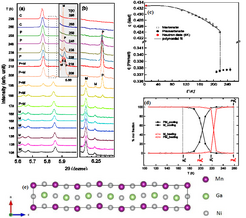The large magnetic field induced strain (MFIS) associated with the change in the shape in magnetic shape memory alloys (MSMA’s) makes this system an important candidate for technological application as magnetic actuators. The strain in these alloys is different from the general magnetostriction. In magnetostriction, the strain is associated with the change in the dimension by application of external magnetic field and it requires structurally homogeneous sample, while in MSMAs it requires a special microstructure, which is provided by the martensite transformation. The martensite transformation is a difussionless phase transformation in which the material undergoes structural transition from a high symmetry cubic austenite phase to a lower symmetry martensite phase by shear deformation. In the martensite phase, the material has twin variants oriented in different direction in the absence of external magnetic field or stress. The change in shape occurs within the martensite phase in the presence of magnetic field due to the re-orientation of the twin variants of the martensite if the magnetocrystalline anisotropy (MCA) is higher than the twinning stress (σtwin).
![(a) Rotation of magnetic moments:[MCA<< ETwin ]](/2876126/original-1518447576.jpg?t=eyJ3aWR0aCI6MjQ2LCJvYmpfaWQiOjI4NzYxMjZ9--679213a1d3e45c199cf0376edfc75d1db786497b)
![(b) MSMA effect: change in shape [MCA>> ETwin]](/2876137/original-1518447577.jpg?t=eyJ3aWR0aCI6MjQ2LCJvYmpfaWQiOjI4NzYxMzd9--1e1e2fbcd4580f99b031777ad12a1e8105944b6a)
As the large magnetocrystalline anisotropy and low twinning stress, in the martensite phase are important parameters for large MFIS, which are closely related to the crystal structure of the martensite phase. As the modulation in the low temperature premartensite and martensite phase can be commensurate or incommensurate, so we use high resolution synchrotron and neutron data and employ the (3+1) higher dimensional superspace group analysis approach to investigate the nature and origin of modulation in MSMA’s.
Our focus:
- To understand the origin of structural modulation in Ni2MnGa and related systems, which may help to design new Heusler alloys for large MFIS.
- Investigate the effect of magnetic field, hydrostatic pressure and residual stresses on the magneto-structural phase transition.
- To search MSMA’s with higher structural and magnetic transition temperatures.

Figure 2: High resolution synchrotron x-ray diffraction study and modulated martensite structure of Ni2MnGa MSMA.
![(a) Rotation of magnetic moments:[MCA<< ETwin ] (a) Rotation of magnetic moments:[MCA<< ETwin ]](/2876126/original-1518447576.jpg?t=eyJ3aWR0aCI6MzQxLCJmaWxlX2V4dGVuc2lvbiI6ImpwZyIsIm9ial9pZCI6Mjg3NjEyNn0%3D--83d4bfd5b5a93eb5196d29003c3d5f1b330c03c1)
![(b) MSMA effect: change in shape [MCA>> ETwin] (b) MSMA effect: change in shape [MCA>> ETwin]](/2876137/original-1518447577.jpg?t=eyJ3aWR0aCI6MzQxLCJmaWxlX2V4dGVuc2lvbiI6ImpwZyIsIm9ial9pZCI6Mjg3NjEzN30%3D--e9ccd6271a1fcd318e2f1406cc11d430ae760c76)
